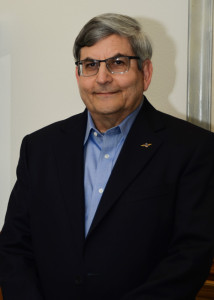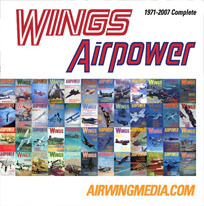 Aviation artist and author, Mike Machat, was recently commissioned to create a 70th anniversary painting for the U.S. Air Force Test Pilot School titled “TPS Generations.” The 24-inch by 48-inch original artwork will feature the NF-16D VISTA, the one-of-a-kind Variable stability In-flight Simulator Test Aircraft, with a series of other aircraft around it.
Aviation artist and author, Mike Machat, was recently commissioned to create a 70th anniversary painting for the U.S. Air Force Test Pilot School titled “TPS Generations.” The 24-inch by 48-inch original artwork will feature the NF-16D VISTA, the one-of-a-kind Variable stability In-flight Simulator Test Aircraft, with a series of other aircraft around it.
“It celebrates the 70 year history of the school showing the very first airplanes, the T-6, the B-25, in a ribbon of airplanes leading up to the F-16 VISTA as the star of the show and then acknowledging the unmanned aerial vehicle; the new role of the Air Force,” said Machat.
The finished work, an oil painting on canvas, will hang in the hallway of the school.
“That makes it a different type of project than a painting for a museum, for the mass public, where they don’t really know much about the airplanes,” said Machat. “This painting is going to be viewed by the people who fly the airplanes and who work on the airplanes and my responsibility is to make sure it’s as accurate as possible for those folks.”
According to Col. Lars Hoffman, USAF TPS commandant, the painting will most likely be unveiled June 13 on graduation day. The artwork was purchased by five anonymous TPS employees and will be donated to the school.
Hoffman stated that the piece will include some personal elements as well. He recalled running the halls of the school, “like a kid in a candy store,” at seven years old, when his father was enrolled at TPS.
“The thing that really sticks in my mind was a flight that my dad did where he put on a full pressure suit, got into an F-104 and zoomed it up above 80,000 feet,” said Hoffman. “He took my brother and I out of school that day to watch him suit up and after he took off we came in and watched him on a tracker camera display on a television screen. It was like watching Superman. My brother and I were just amazed to see our dad do that.”
The painting will show an NF-104 with a rocket motor on it, in a vertical ascent as a tribute to that memory.
The image will also include elements representing cyber and space testing, which is being increasingly incorporated into the TPS curriculum.
“The focal point for today is the NF-16D VISTA aircraft that we fly. It’s the variable stability F-16 that we use in the curriculum. It’s core to our curriculum. We use it for research and some of the projects that we’re doing today are breaking new ground, like auto-air collision avoidance, auto-ground collision avoidance,” said Hoffman. “That really represents the leading edge of what we’re doing today and it’s a beautiful airplane.”
To ensure the accuracy of his work, Machat visited the school where he photographed the VISTA and asked Calspan operations manager Jason Kirkpatrick questions about the aircraft.
“Many commandants ago, they coined the phrase that the VISTA is ‘the crown jewel of the test pilot school,'” said Kirkpatrick.
The VISTA can be configured to fly like any other aircraft.
Bob Dobis, senior technician is one of only four maintainers to work on that “jewel.”
“The plane has been modified so it has variable flight control computers, which allow certain parameters to be loaded into the jet,” said Dobis. “It gives the students who fly it a really broad range of different flight characteristics of aircraft, so it can fly like other airplanes. It can fly in certain configurations that other planes can’t. It’s the only one in the world, and its here.”
“The painting will convey to future generations as well as veterans the entire history in one glance,” said Machat. “The beauty of artwork is to be able to create things that could never happen in real life. They could’ve never assembled this formation of airplanes in 70 years, but I could do it in my artwork. It’s a deep responsibility to tell the story and do it accurately and pay tribute to all the great pilots that have flown it.”
In addition to the painting, Machat is designing a 70th anniversary logo which will feature the Howland Owl, from the heritage patch, riding the VISTA.
“The 70th anniversary logo is going to have elements from the TPS heritage patch from way back in the day in the 1940’s which is Howland Owl,” said Kirkpatrick. “Col. Hoffman envisions the new logo, done specifically for this year, will go on coffee mugs and t-shirts and anything you can think of to celebrate the anniversary this year.”
According to Hoffman, the logo will also be made into an applique to be placed on the aircraft.
[image src=”http://airwingmedia.com/wp-content/uploads/2014/06/Mike-Machat-Edwards-NF16-2.jpg” responsive=”true” lightbox=”true”]
“My number one priority is to set this school up for success going into the future,” said Hoffman. “So as we celebrate the 70th anniversary today we’re really looking forward to the 75th and 80th anniversaries and where we need to be in those milestone years, to be viable. To still be the best in the world as we are today.”
Machat is the author of “World’s Fastest Multi-Engine Piston Aircraft: The Story of Republic’s The XR-12 Rainbow and Hughes XF-11,” and co-author of “From Props to Jets.”
The award-winning artist has had his work permanently displayed in venues including the Air Force Flight Test Museum at Edwards and the Smithsonian National Air and Space Museum in Washington D.C.
His most recent work, “Fly DOUGLAS!” is a 10-foot by 20-foot mural located in the Museum of Flying at the Santa Monica Airport. The mural, which features the 10 Douglas airliners built in Southern California, was painted primarily during museum hours making it a “living exhibit.”
“I’ve been supporting Air Force activities through artwork since 1982. I’ve done 28 Edwards related paintings both for the base and the Edwards art program, including this one, and it’s an honor to do it. Not very many people have the opportunity to come out here and paint, fly these airplanes and research them, it’s very special,” said Machat. “From my perspective as an artist, the most fascinating aspect of what we just did out there is that the technology sitting in that airplane was science fiction when the school first started. Forget it wasn’t made yet; it wasn’t even thought of.”
Original article



